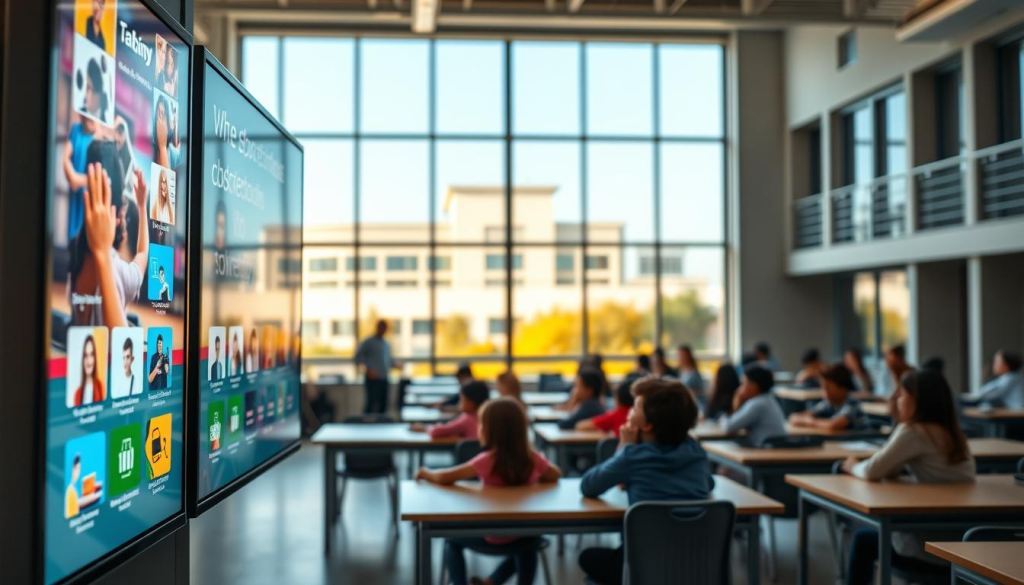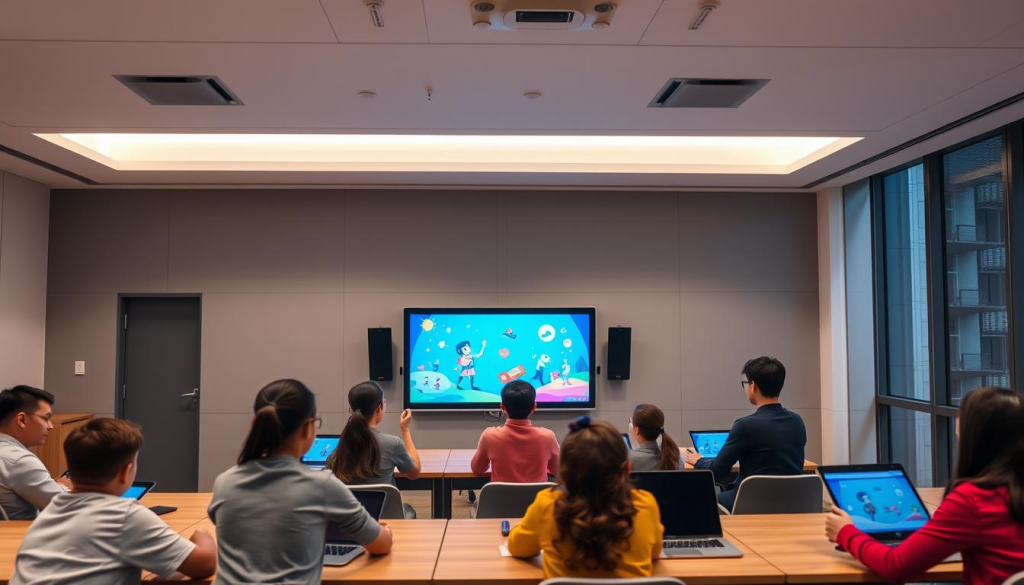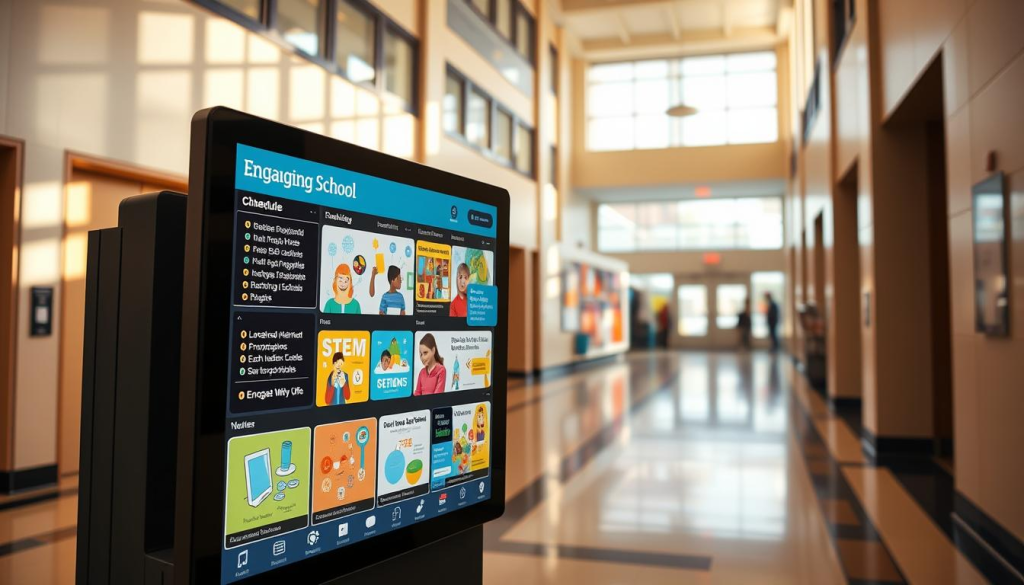Digital signage is changing how schools talk to students, teachers, and parents. It’s a new way to share news and updates. This technology makes learning spaces more alive and interactive.
Studies show a big jump in student interest when digital signs are used. They help students remember more of what they learn. Schools across the U.S. are seeing how digital signage can make learning better and more fun.

Key Takeaways
- Digital signage replaces traditional bulletin boards, improving communication efficiency.
- 30% increase in student engagement when digital signage is used in classrooms.
- Real-time updates help reduce navigation-related issues on campus by 25%.
- Over 70% of educators believe digital signage enhances the learning experience.
- Studies show interactive features boost student motivation and participation.
The Importance of Digital Signage in Schools
Digital signage in schools is key for making learning fun and interactive. It helps schools share information in a way that grabs everyone’s attention. This technology makes sure everyone in the school community gets the latest news and updates.
Creating Dynamic Learning Environments
Digital signage changes the vibe in schools. It makes students more aware of what’s happening on campus. This leads to a 40% increase in student knowledge about school events.
It also helps schools celebrate achievements and share educational content. This builds a strong sense of community. With digital signage, 73% of schools see more student involvement and participation.
Improving Communication Channels
Good communication is essential in schools. Digital signage makes it better by sharing updates in real-time. This ensures 100% of the school community stays informed, like when there’s a schedule change due to bad weather.
Old methods like bulletin boards and paper flyers can’t keep up. Digital signage updates instantly, keeping everyone in the loop. Schools save money on printing and use it to improve education.
Benefits of Digital Signage in Education
Digital signage in schools brings big changes that make learning better. It uses eye-catching visuals to grab students’ attention and get them involved. This way of sharing information makes lessons more exciting and fits how today’s students like to learn.
Engagement through Visual Content
Visuals are key to keeping students interested, with studies showing a 50% boost in engagement with interactive digital signs. Almost all students notice and remember what they see on digital signs. This shows how well it works for getting messages across.
More than 70% of US colleges use digital displays now. This move away from old printed stuff saves a lot of money. Schools spend a lot on paper, ink, and toner, but digital signs can cut these costs.
Real-Time Updates for Educational Institutions
Digital signs make sharing news fast and easy. Schools see a big speed-up in sharing updates with these systems. They use it to post schedules and announcements, saving staff a lot of time.
This helps students too, as they feel more in the loop about school events. Digital signs are key in emergencies, helping reach 90% of students quickly with important messages.
Transforming School Communication Systems
Digital signage is changing how schools talk to each other. It makes sharing information easier for everyone. Schools can now send out important news to parents and students quickly.
Centralized Information Distribution
Digital signage makes it easy to share news across the school. Schools can post messages, schedules, and event highlights on screens. This way, everyone gets the latest updates.
It’s great for getting news out fast. For example, it can alert everyone about bus schedule changes or what’s for lunch. This makes daily life at school smoother and keeps everyone in the loop.
Reaching Parents and Students Effectively
Digital signage makes schools feel more welcoming. It helps everyone understand important messages, no matter their language. It also makes school events more fun and engaging.
Showing off student successes on screens boosts school pride. It motivates students and gets parents involved. This makes school activities more exciting for everyone.
Interactive Displays for Education
Interactive displays change the classroom into a lively place to learn. They make lessons fun and engaging. Students get to participate more, making learning fun and effective.
Enhancing Classroom Interaction
Interactive displays boost classroom interaction. They have features like multi-touch, allowing up to 40 points of touch at once. This encourages teamwork and brainstorming on the screen.
Using games in assessments raises student participation by 40%. Many students prefer these over regular quizzes.
Incorporating Multimedia in Lessons
Interactive displays make lessons more dynamic. High-resolution displays, like Clear Touch’s A+ series, show content clearly. This helps all students, including those with disabilities.
Digital signage improves learning and keeps everyone updated on school news. It makes learning accessible and keeps everyone informed.

Digital Signage Solutions for K-12 Schools
Digital signage solutions make communication better in K-12 schools. There are many digital displays for different needs. Schools can pick from big displays for hallways or touchscreens for classrooms.
It’s important to think about the school’s layout, who will see the signs, and the budget. This helps choose the right technology for schools’ communication goals.
Types of Digital Displays Available
There are many digital displays that change schools for the better. These include:
- Large-format displays for common areas.
- Interactive touchscreens that engage students directly.
- Digital menu boards to provide dynamic cafeteria options.
- Polling systems for student participation in decision-making.
Systems like ScreenCloud and NoviSign help K-12 schools a lot. They offer real-time updates and easy content management. For example, ScreenCloud sets up digital signage quickly and easily.
NoviSign lets you update content wirelessly. Changes are seen in minutes.
Choosing the Right Technology for Your School
Choosing the right digital signage involves looking at functionality, ease of use, and support. Schools using ScreenCloud see better interaction and performance. They also get 24/5 support for any tech problems.
NoviSign is easy for users, even students. It has customizable templates and automated scheduling. Schools can also use Google Slides and Dropbox Gallery for easier content sharing.
In conclusion, picking the right digital signage for K-12 schools is key. It’s about understanding the options and choosing technology that fits the school’s goals. A smooth transition to digital can greatly improve communication and the learning experience for everyone.
Digital Signage in Schools: A Case Study
Digital signage in schools has a big impact on students and staff. Places like the Interlochen Center for the Arts show how it changes learning spaces. They use over 65 digital signs across 1,200 acres, making their campus lively and educational.
Successful Implementation Examples
Interlochen is a leader in using digital signage in schools. They use a lot of images and videos, which students find interesting. This makes learning more fun and interactive.
Impact on Student and Staff Engagement
Switching to digital signs at Interlochen has many benefits. The technology is easy to set up and use, even for those who aren’t tech-savvy. This makes it simple to keep everyone informed.
Digital signs also help in emergencies by sending out alerts quickly. They make the school safer and more connected. Plus, they help students find their way around big campuses.
Digital signage does more than just share information. It can show events, grades, and even what’s for lunch. It makes updates easy and helps the environment by reducing paper waste.
School Digital Signage Software Overview
School digital signage software helps improve communication and engagement in schools. It’s important to know the key features and easy-to-use management tools. This helps schools enhance their communication strategies.
Features to Look For
When picking the right school digital signage software, look at several features. Key aspects include:
- Ease of Use: A simple interface makes it easy for staff to use without needing a lot of training.
- Content Scheduling: This feature lets schools schedule content automatically. It saves time and boosts efficiency.
- Integration Capabilities: Being able to connect the digital signage with other systems ensures smooth information flow.
- Real-Time Updates: This feature allows for quick sharing of important information. It helps in faster communication and clearer announcements.
User-Friendly Management Tools
Good management tools make it easy to manage digital signage on many screens. Schools should focus on:
- Remote Access: Tools like Screenly let IT admins manage screens from anywhere. This avoids the need to travel to each screen.
- Content Playlists: Schools can set up different playlists for different screens. This makes content delivery more tailored to specific needs.
- Monitoring Capabilities: This ensures any playback issues are fixed quickly. It keeps information flowing smoothly.
By using school digital signage software, schools can cut paper waste by 50% and boost communication by 75%. They can share updates in under 5 minutes. This greatly improves how things work.
Schools that use this software well see better student engagement and happiness. It’s a valuable tool for modern education.
| Benefit | Statistic |
|---|---|
| Reduction in Paper Waste | 50% |
| Increased Communication Effectiveness | 75% |
| Boost in Student Engagement | 40% |
| Decrease in Missed Events | 30% |
Creating Engaging School Digital Signage Content
Creating effective school digital signage content needs a strategic plan. It should engage students, staff, and parents. Schools should focus on sharing important info quickly and in a way that’s easy to see.
It’s important to follow best practices for making content. This ensures messages hit home with everyone. Using smart display strategies can make this content even more impactful, keeping everyone informed and interested.
Best Practices for Content Creation
Start by knowing who you’re talking to. Messages should be clear and to the point. This is because seeing images is much faster than reading text.
Use bright graphics, animations, and videos to grab attention. Tools like the Yodeck platform make it easy to manage and update content for school digital signage.
- Create content that highlights upcoming events and activities to build community spirit.
- Use live feeds of the school calendar to keep families up to date with schedule changes.
- Make sure everyone can access the content, making it more inclusive.
Display Strategies for Maximum Impact
To keep viewers interested, schools should mix up their display strategies. Changing content often keeps it fresh and interesting. Live updates are also key, helping avoid scheduling problems during busy times.
Good wayfinding digital signage also makes corridors safer. It helps reduce crowding during busy times like recess and lunch.
| Strategy | Benefit |
|---|---|
| Regular Content Rotation | Maintains viewer interest and promotes engagement |
| Live Calendar Feeds | Keeps the community informed about changes |
| Visual Content Utilization | Increases retention of information |
| Real-Time Updates | Enhances communication and minimizes scheduling conflicts |
Digital signage not only improves communication but also makes the campus cleaner by reducing paper waste. By using these strategies, schools can create digital experiences that boost engagement for everyone.

Enhancing Safety with Digital Signage
In today’s schools, safety is a big concern. Digital signage helps a lot by sending out emergency messages quickly. It uses new tech to make schools safer for everyone.
Emergency Communication Capabilities
Digital signage works with panic alert systems, like Alyssa’s Law. This law makes schools use direct alerts to first responders. Schools can send messages fast, helping everyone stay safe.
For example, Necedah Schools cut lockdown times by 50%. This shows how well real-time alerts work.
Real-Time Alerts in Schools
Digital signage is great for sending out emergency alerts. It helps students with hearing issues get messages quickly. Schools like Merkel ISD and Burkburnett CISD use it with crisis alert systems.
Digital signs help during evacuations and guide new students. They keep everyone ready for emergencies. Schools show safety tips and important numbers on these signs.
Even though digital signs cost a lot, they make schools safer. They are worth it for the safety they bring to students and staff.
| School District | Integrated System | Impact |
|---|---|---|
| Necedah Schools | Emergency Alert Platform | 50% reduction in lockdown time |
| Merkel ISD | Rise Vision with CrisisGo | Real-time emergency alerts across campuses |
| Burkburnett CISD | Centegix Crisis Alert | Instant display of critical alerts |
Conclusion
Digital signage in schools is a big step forward in education. It uses technology to share information fast and make learning fun. Students today expect quick access to info, just like they do with their phones and tablets.
Digital signage is also super flexible. It can update info instantly, send out emergency alerts, and make learning interactive. It can handle everything from cafeteria menus to event updates. This makes it key for effective school communication.
Using digital signage in schools is more than just keeping up with tech. It creates a lively learning space that gets students involved and keeps them safe. As schools change, digital signage will play a bigger role in making learning exciting.
FAQ
What is digital signage in schools?
Digital signage in schools uses electronic displays to share information. It replaces old bulletin boards with dynamic updates. This way, everyone gets the latest news and announcements.
How does digital signage improve communication in educational institutions?
Digital signage makes communication better by sharing information in one place. Schools can update messages easily. This ensures everyone stays informed and involved.
What are the benefits of using digital signage for education?
Digital signage boosts engagement with interactive content. It also keeps everyone updated in real-time. This creates a unified learning environment and improves learning experiences.
Can digital signage be used for emergency communication in schools?
Yes, digital signage is great for emergency alerts. It quickly shares critical information across screens. This ensures students and staff get timely updates during emergencies.
What features should school digital signage software have?
Look for software that’s easy to use and schedule content. It should also integrate with current systems and allow for quick updates. This makes managing displays simple for IT teams.
How can schools create engaging content for digital signage?
Schools should use clear messages and eye-catching graphics. Rotating content and adding videos can grab more attention. Making sure it’s accessible helps reach more people.
What types of digital signage solutions are available for K-12 schools?
Schools have many options, like big displays, touchscreens, and LED screens. Choosing the right one depends on their needs, layout, and budget. This ensures effective communication and engagement.
How do interactive displays benefit classroom learning?
Interactive displays make learning more engaging. They let teachers use multimedia in lessons. This encourages teamwork and makes learning fun, with quizzes and games included.
What are some successful examples of digital signage implementation in schools?
Schools that use digital signage see better communication and more student involvement. They feel more connected as a community. These examples show how digital signage can positively impact schools.
What strategies can schools use to ensure effective digital signage messaging?
Schools should keep messages simple and update content often. Rotating content keeps things fresh. This keeps everyone interested and engaged with the displays.